Native Son – October, 2012
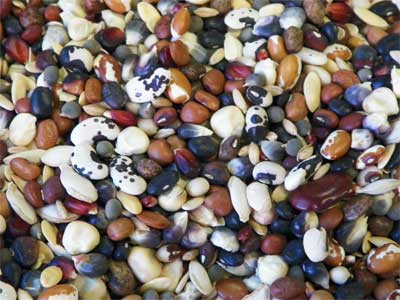
A sample of Native Seeds heirloom seeds.
All photos courtesy of Steven Chamblee.
Humble Beginnings: Teosinte
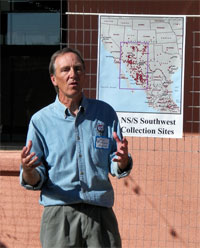
Native Seeds/SEARCH Director Bill McDorman talks “seeds and people.”

So I’m packed into the crowd of about 100 garden writers visiting the Native Seeds/SEARCH facility in Tucson, Arizona, listening to an informal introduction to the organization by Executive Director Bill McDorman, who suddenly asks us, “Does anyone know about Teosinte?” My eyes bulge, my heart skips about three beats, and my mouth blurts out, “It’s the progenitor of modern corn … actually, ALL corn!”
Bill is shocked, and his expression says few had ever answered that question before. The garden writers are shocked, for they turn in unison and stare at me like I am some sort of freaky alien from Planet Whacko. Truthfully, I am shocked! My brain turns inside out…. “Where did we learn the word ‘progenitor’ … if that’s even a real word?” At this point, I sink down a bit, and try to hide … like that time in high school when my teacher asked the class Ingmar Bergman’s profession (filmmaker) and I proudly yelled out, “Ventriloquist!” (The class exploded and Mr. Brodnan just put his face into his hands. To make it worse, none of them had ever heard of Edgar Bergen or Charlie McCarthy.)
Well, it turns out that “progenitor” actually is a real word (basically, it means “an ancestral originator”) and the right one. To be honest, I have no idea how that little literary seed got buried in my brain, but fortunately, it sprouted at just the right moment. Teosinte (“tee — oh — sin — tay”) is a different story. About ten years ago, I got this really cool poster, “Indian Corn of the Americas,” featuring about 30 varieties of corn, from ancient to heirloom to modern types. Among the spectacularly speckled, oddly overlapping, and terrifically triangular-kernelled varieties is this tiny sliver of a grass infructescence (fruiting structure) labeled, “Teosinte: dating from 5000 BC, a wild grass bred with another, Tripsicum, to create the possible ancestor of modern corn.” (Subsequent research backs this up to at least 6300 BC, but who’s counting?)
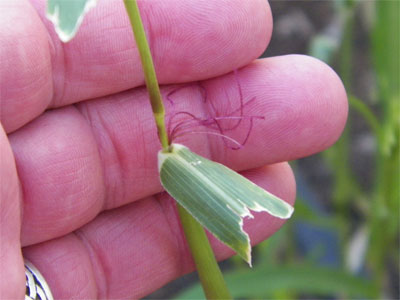
Tiny styles on Teosinte hint at future corn “silk.”
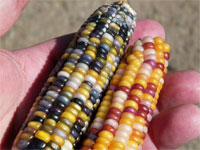
Native Seeds preserves rare varieties, such as this glass bead corn.
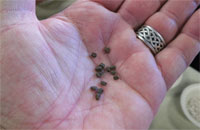
Tiny, hard, and angular, Teosinte seeds don’t resemble modern corn kernels.
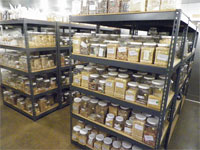
One of several refrigerated warehouses that store millions of carefully cataloged seeds.
To a guy like me, who loves to chug from the bottle labeled “The Realm of Possibilities,” my intemperate mind becomes besotted with the idea of this little grass, this little spark … being gently kindled by observant minds that never sought nor saw recognition; being delicately coaxed by calloused fingers that desired only sustenance; being preserved and protected by simple communities for millennia that truly understood the value of a few hard kernels that were slightly larger than the ones the year before … igniting into one of the human world’s primary food sources (as well as — are you ready? — livestock feed, alcoholic beverages, automobile fuel, cooking oil, paper products, textiles, pharmaceuticals, plastics, disinfectants, soaps, and explosives). Well, that’s just craaaaazy good!
What really amazes me is how far a little thing like Teosinte can go if it is nurtured. The General Sherman Sequoia (275 feet tall, 30 feet in diameter) arose from a seed smaller than the head of a hatpin. The massive blue whale (eventually 98 feet long, 200 tons) grows from an egg the size of this dot (.) to 40 feet long in about 18 months. The invention of the integrated circuit in the late 1950s (too many people involved to credit a single person) has led to me being able to write this article on a laptop while performing worldwide research on my phone … while listening to the smooth suave jam of the Brazilian band Bossacucanova. Yes, I am aware that this concept is not always a good thing (kudzu, fire ants, plague, Nazis), but I try to focus on the positive. (Even so, am I the only person who’s noticed that “Neanderthal” follows “Nazi” not only in real life, but in the dictionary as well?)
Back home, the change of seasons blows a new wind that carries upon it transformation. Like leaves falling from trees, subtle hints are dropping from the sky and I am being gently touched/nudged in many ways to enter a new chapter in my life. A young man named Johnny has visited me in the garden several times in the past few months, and is always particularly excited to see me. He has some disabilities that confine him to a wheelchair, but his zeal for life makes the chair unimportant to me, as I see a young man who accepts life on its own terms, and works within that. (There is a lesson in there for me, I’m sure.)
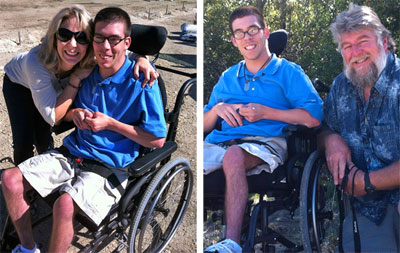
Left photo: Johnny Sauermann and his mom, Leah.
Right photo: Johnny and Steven take five in the shade.
A few weeks ago, before the Tucson trip, I was having a bear of a time trying to get a donated greenhouse frame into order, as the ground where I chose to put it was so hard that I couldn’t put the steel support posts into the rock. Shovels, picks, mattocks, and sledgehammers just bounced off the rock like BB’s pinging off the Death Star. I got so worked up about it all that I grumbled some choice scatology, punted the pipes with my steel-toes, and walked away to cool off. Still grousing, I looked skyward, and rhetorically asked, "Why am I doing this stupid project? Why am I driving myself crazy with all of this?!?!? Arrrrgh!!!!" No answer rolled forth from the clouds, so I yelled, “Fine! Perfect!” When I looked back down, I saw Johnny across the parking lot, and I think he was giggling at my antics. It all made sense in an instant. I now had my direction, my purpose for this greenhouse beyond simply over-wintering tropical plants. I looked skyward and smiled. I had my Teosinte.
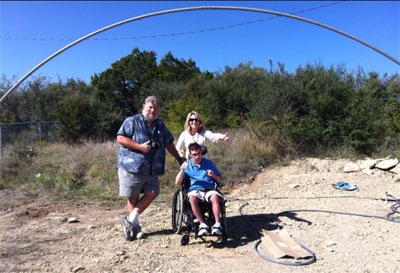
Johnny, Leah, and Steven under the first rib of the Teosinte greenhouse.
Yesterday, Johnny and his mom, Leah, came up to view the greenhouse site. There really wasn’t much to see; piles of curved pipes, a few busted bags of concrete, and the corner posts set. But I wanted Johnny to witness it now, in its “nothingness,” so he could watch it grow. He seemed unimpressed. But when Leah and I managed to set the first steel rib in place upon the west side corner posts, Johnny’s face lit up. He could envision the 12-foot-high ceiling of the 60-foot-long quonset, and he grinned with sheer delight. It was the same look that every face wears the first time you see your seedlings up. That expression is the genesis of what I hope to be a confluence of humans, plants, soils, ideas, and imaginations that, hopefully, will meld together into an environment of learning, compassion, respect, laughter, and love. Some folks would simply call it a greenhouse, but I want more than that. I want a place where observant minds and calloused fingers learn to preserve and protect not only seeds, but dreams and values. I want a place where nature’s gifts teach us how to be better people. It’ll be a place built of steel, glass, sweat, and hope. It will be called Teosinte … and with luck and a little nurturing, it just might become a progenitor of great things.
Go to www.nativeseeds.org for more info on Native Seeds/SEARCH.
This quick short video by Vitalise is another one of the nudges that fell from the sky, inspiring the Teosinte Project. Click and enjoy!
About the author: Steven Chamblee is the chief horticulturist for Chandor Gardens in Weatherford and a regular contributor to Neil Sperry’s GARDENS magazine and e-gardens newsletter. Steven adds these notes:
Come out and enjoy the beautiful autumn weather at Chandor Gardens! Special events include:
• Goblins in the Gardens – Sunday, October 28; 12 noon to 4 p.m.
A spook-free, daytime, trick-or-treat experience for the whole family. A themed area will be decorated for personal photos. Costumes are encouraged. Guests 18 or under must be accompanied by an adult. Admission: Adults $2, children FREE.
• T’ai Chi Classes – Saturdays 10:00 to 11:00 a.m.
Experience T’ai Chi/Chi Kung classes in the Gardens every Saturday with instructor Michael Anderson. T’ai chi requires no experience and helps to relax you and refresh your energy. Wear shoes and comfortable clothing. Classes held outside, weather permitting. $10. For more information, contact Michael Anderson at 817-596-0550.
Visit www.chandorgardens.com for all the details, or call 817-613-1700. Then just take I-20 west to exit 409, hang a right, go 2.1 miles and hang a left on Lee Avenue. Head straight 12 blocks and you’re driving in the gates. Call 817-361-1700 for more information. You can always go to www.chandorgardens.com for a picture tour and details.
I can always use another road trip! Let me know if you’d like me to come out and speak to your group sometime. I’m low-maintenance, flexible, and you know I like to go just about anywhere. No city too big; no town too small. Just send me an e-mail at schamblee@weatherfordtx.gov and we’ll work something out.
